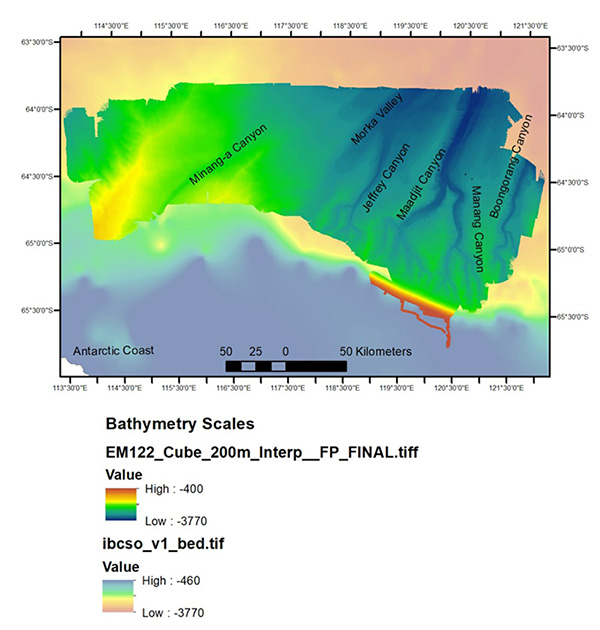 The Standing Committee for Undersea Feature Name (SCUFN) has approved some new feature names for the East Antarctic continental margin. The area is seaward of the Sabrina Coast of WIlkes Land between 114 degrees East and 122 degrees East. The new names apply to a suite of submarine canyons and a submarine valley.
The Standing Committee for Undersea Feature Name (SCUFN) has approved some new feature names for the East Antarctic continental margin. The area is seaward of the Sabrina Coast of WIlkes Land between 114 degrees East and 122 degrees East. The new names apply to a suite of submarine canyons and a submarine valley.
Five of the names are words provided by the Noongar People, the Australian Aboriginal group whose traditional lands would have been adjacent to the Sabrina Coast before Antarctica and Australia separated around 135 Million years ago. The sixth canyon is named after an eminent Australian marine scientist.
Geoscience Australia has produced a fly-through of the canyons available via YouTube.
The canyon names and their meaning are as follows:
Boongorang Canyons (Blowing in the wind) – this canyon system was mapped during a break from other operations due to bad weather
Manang Canyons (Pool of Water Canyon) –named after scour pools in the canyon floor
Maadjit Canyons (Water Serpent Canyon) – based on unusual sinuosity of the western branch of the canyon
Morka Canyon (Winter Canyon) – this canyon was likely only active during intense glacial periods
Minang-a Canyon (Whale Canyon) – in honour of the many humpback whales that we saw on the voyage
A final sixth canyon system was called Jeffrey Canyons (after Shirley Jeffrey, an eminent Australian microalgae researcher) – these canyons contained a thick accumulation of single-celled algae (diatoms).
The canyons were mapped in 2017 by scientists on the Marine National Facility vessel RV Investigator, by a team including Assoc. Prof. Leanne Armand (ANU), Dr Phil O’Brien (Macquarie University) and Dr Alix Post (Geoscience Australia). The voyage was supported by Marine National Facility, and particularly Tara Martin and Stuart Edwards by assisting with multibeam acquisition and processing. This project is supported through the Australian Government’s Australian Antarctic Science Grant Program (AAS #4333). The proposal for new names was greatly assisted by Ursula Harris at Australian Antarctic Division and by the Australian Hydrographic Office.

